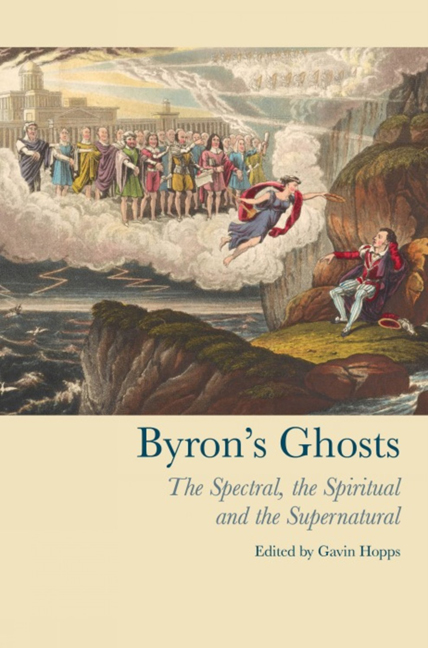Book contents
- Frontmatter
- Dedication
- Contents
- Acknowledgements
- Texts and Abbreviations
- Introduction: The Re-Enchantment of Romanticism
- Chapter 1 Determining Unknown Modes of Being: A Map of Byron's Ghosts and Spirits
- Chapter 2 Shades of Being: Byron and the Trespassing of Ontology
- Chapter 3 Byron and the Noonday Demons
- Chapter 4 Conjuration and Exorcism: Byron's Spectral Rhetoric
- Chapter 5 Byron avec Sade: Material and Spectral Violence in Childe Harold's Pilgrimage Canto IV
- Chapter 6 ‘’Twixt Life and Death’: Childe Harold's Pilgrimage, Don Juan and the Sublime
- Chapter 7 Byron, Ann Radcliffe and the Religious Implications of the Explained Supernatural in Don Juan
- Chapter 8 The Haunting of Don Juan
- Chapter 9 Being neither Here nor There: Byron and the Art of Flirtation
- Afterword: Blowing on a Dead Man's Embers: Byron's Biographical Ghosts
- Bibliography
- Notes on Contributors
- Index
Chapter 5 - Byron avec Sade: Material and Spectral Violence in Childe Harold's Pilgrimage Canto IV
- Frontmatter
- Dedication
- Contents
- Acknowledgements
- Texts and Abbreviations
- Introduction: The Re-Enchantment of Romanticism
- Chapter 1 Determining Unknown Modes of Being: A Map of Byron's Ghosts and Spirits
- Chapter 2 Shades of Being: Byron and the Trespassing of Ontology
- Chapter 3 Byron and the Noonday Demons
- Chapter 4 Conjuration and Exorcism: Byron's Spectral Rhetoric
- Chapter 5 Byron avec Sade: Material and Spectral Violence in Childe Harold's Pilgrimage Canto IV
- Chapter 6 ‘’Twixt Life and Death’: Childe Harold's Pilgrimage, Don Juan and the Sublime
- Chapter 7 Byron, Ann Radcliffe and the Religious Implications of the Explained Supernatural in Don Juan
- Chapter 8 The Haunting of Don Juan
- Chapter 9 Being neither Here nor There: Byron and the Art of Flirtation
- Afterword: Blowing on a Dead Man's Embers: Byron's Biographical Ghosts
- Bibliography
- Notes on Contributors
- Index
Summary
In a provocative essay entitled ‘Kant Avec Sade’, Lacan aligns these two (apparently) polarized Enlightenment thinkers in terms of their pursuit of a pure abstraction of form: Kant's insistence on the purity of the ‘categorical imperative’ as the basis of the moral law is mirrored and reconstituted through Sade's search for a pure form of violence, which remains tied to the moral law – to the idea of prohibition – even as it tries to break with it. Commenting on this ‘ideal couple’, Žižek asks whether the ‘sublime disinterested ethical attitude is somehow identical to, or overlaps with, the unrestrained indulgence in pleasurable violence?’ Both are emptied of pathological feelings or motivations and both aim to achieve a strict purity of structure divorced from pathos. Additionally, Alenka Zupančič has shown how Kant's grounding of the moral law in the ‘endless progress of the immortality of the soul’ is replicated in the Sadean fantasy of an immortal body that is tortured endlessly but does not display or succumb to the marks of violence. In other words, material violence becomes translated into a spectral, figural version of itself.
In this chapter, I am proposing an alignment of another couple, Byron and Sade, which both enacts and moves beyond the kind of mirroring that we see in Lacan's reading. This link between Byron and Sade has been articulated before, most famously by Sainte-Beuve in his 1843 article in La Revue des Deux Mondes:
… j'oserai affirmer, sans crainte d’être démenti, que Byron et de Sade (je demande pardon du rapprochement) ont peut-être été les deux plus grands inspirateurs de nos modernes, l'un affiché et visible, l'autre clandestine – pas trop clandestin.
Repeating the split between the material and spectral, the visible and invisible, Sainte-Beuve posits sade almost as Byron's spectral other and connects them both to modernity. This connection was taken up also by Gustave Flaubert, as noted by Mario Praz, whose chapter on Sade in The Romantic Agony culminates with Byron.
- Type
- Chapter
- Information
- Byron's GhostsThe Spectral, the Spiritual and the Supernatural, pp. 131 - 146Publisher: Liverpool University PressPrint publication year: 2013

